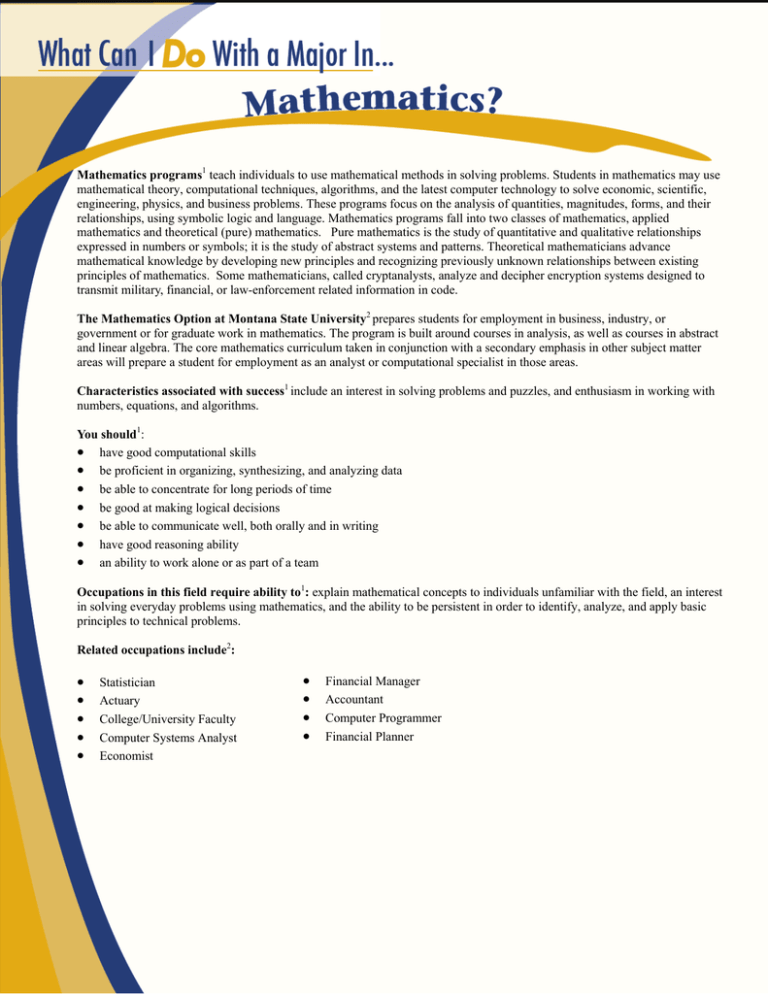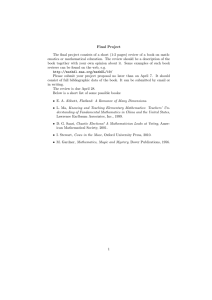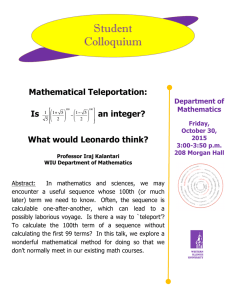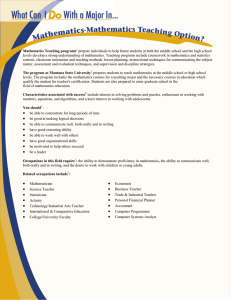Mathematics programs
advertisement

Mathematics programs1 teach individuals to use mathematical methods in solving problems. Students in mathematics may use mathematical theory, computational techniques, algorithms, and the latest computer technology to solve economic, scientific, engineering, physics, and business problems. These programs focus on the analysis of quantities, magnitudes, forms, and their relationships, using symbolic logic and language. Mathematics programs fall into two classes of mathematics, applied mathematics and theoretical (pure) mathematics. Pure mathematics is the study of quantitative and qualitative relationships expressed in numbers or symbols; it is the study of abstract systems and patterns. Theoretical mathematicians advance mathematical knowledge by developing new principles and recognizing previously unknown relationships between existing principles of mathematics. Some mathematicians, called cryptanalysts, analyze and decipher encryption systems designed to transmit military, financial, or law-enforcement related information in code. The Mathematics Option at Montana State University2 prepares students for employment in business, industry, or government or for graduate work in mathematics. The program is built around courses in analysis, as well as courses in abstract and linear algebra. The core mathematics curriculum taken in conjunction with a secondary emphasis in other subject matter areas will prepare a student for employment as an analyst or computational specialist in those areas. Characteristics associated with success1 include an interest in solving problems and puzzles, and enthusiasm in working with numbers, equations, and algorithms. You should1: have good computational skills be proficient in organizing, synthesizing, and analyzing data be able to concentrate for long periods of time be good at making logical decisions be able to communicate well, both orally and in writing have good reasoning ability an ability to work alone or as part of a team Occupations in this field require ability to1: explain mathematical concepts to individuals unfamiliar with the field, an interest in solving everyday problems using mathematics, and the ability to be persistent in order to identify, analyze, and apply basic principles to technical problems. Related occupations include2: Statistician Actuary College/University Faculty Computer Systems Analyst Economist Financial Manager Accountant Computer Programmer Financial Planner MSU graduates (Bachelor’s degree) were hired in the following selected fields3: Adjunct Instructor- Montana State University Crime Lab Forensic Scientist- State of Texas Engineer- Honeywell Inc Human Resources Support- Wyoming Medical Center Mathematician– National Security Agency Mechanical Engineer- General Dynamics Pilot- US Air Force Recruiter- US Air Force Solutions Designer- Zoot Enterprises, Inc Sales Manager- Legacy Financial Services Technologist 3- Phidine Brown Engineering Salary averages of survey respondents: (# of respondents in parentheses)3 2007: MT: $ 28,360 (2) 2006: MT: Insufficient Data 2005: MT: Insufficient Data 2004: MT: Insufficient Data Out of State: Insufficient Data Out of State: Insufficient Data Out of State: Insufficient Data Out of State: Insufficient Data Graduates from this program entered programs of further education at these institutions: Montana State University Purdue University Colorado State University University of California Northwestern University University of California– Berkeley University of Colorado University of Wisconsin Other Sources of Information: American Mathematical Society (AMS): http://e-math.ams.org American Statistical Association (ASA): www.amstat.org Association for Women in Mathematics (AWM): www.awm-math.org Canadian Mathematical Society (CMS): http://camel.math.ca International Statistical Institute (ISI): www.cbs.nl/isi Mathematical Association of America (MAA): www.maa.org National Council of Teachers of Mathematics (NCTM): www.nctm.org Society for Industrial and Applied Mathematics (SIAM): www.siam.org Society of Actuaries: www.soa.org Department of Mathematics, Montana State University: www.math.montana.edu 1 University of Oregon. 2007. Created by intoCareers, a unit of the University of Oregon. Montana information Montana Career Information System. Discover: 2008 by ACT, Inc. 2 Montana State University Department of Mathematical Sciences 3 Montana State University Career & Internship Services Number of graduates/number of respondents: 2004: 3/2; 2005: 5/2; 2006: 11/7; 2007: 6/5







